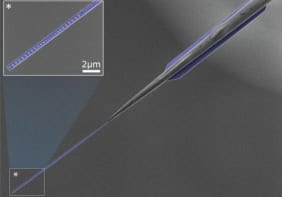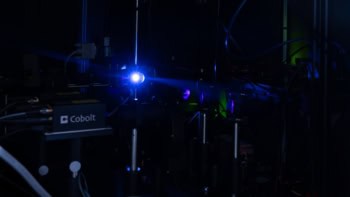Liquid crystal displays (LCDs) are currently made by sandwiching a liquid crystal between two pieces of glass, but Dick Broer and colleagues at Philips in the Netherlands have shown how to make an LCD that is more like an open sandwich. They used ultraviolet light to trap a thin film of liquid crystal between just a single piece of glass and a layer of polymer. This technology could enable large displays to be painted on walls or flexible displays to be integrated into clothing (D Broer et al 2002 Nature 417 55).
LCDs are used in a broad range of displays, from those in watches and calculators to computer displays and flat-screen televisions. In 2000 almost two billion LCDs were made by an industry worth $20bn. But existing manufacturing techniques are relatively expensive and restrict the size and shape of the displays. In contrast, the method used by Broer and co-workers is potentially cheaper and more versatile. It could lead to larger, thinner displays that could be “painted” onto almost any surface.
A liquid crystal flows like a liquid but is made up of rod-shaped molecules that line up in a particular direction. In a conventional LCD, an electric field is applied across a layer of liquid crystal, changing the alignment of the molecules and altering their light-transmitting properties. The glass substrates are coated with a layer of conducting material.
Instead, the Philips’ group coated a single piece of glass with a thin film containing a mixture of liquid crystal, a monomer – a polymer building block – and an ultraviolet-absorbing dye. The mixture was first exposed to ultraviolet light with a wavelength of 400 nm through a mask. The light caused the monomer molecules to join together to form a solid polymer, a process known as polymerization. This created a network of polymer walls within the film, corresponding to the pattern on the mask.
The mask was removed and the mixture was then exposed to ultraviolet radiation at 340 nm. This led to polymerization on the surface of the mixture, but not further down where the intensity of the light was lower due to its absorption by the dye. The effect of this step was to separate the polymer and liquid crystal into distinct layers, and the combined steps resulted in a network of polymer boxes each enclosing a small amount of liquid crystal. Each box measured 500 by 500 µm square and 10 µm deep, with a lid about 10 µm thick. The walls, which hold the display together, were about 100 µm wide.
However, Broer and colleagues admit that there are hurdles to overcome before their technique could be used commercially. Since all of the electrodes needed to power the LCD must be on a single substrate, the resulting electric field exists within the plane of the liquid crystal layer, rather than across it. This impedes the alignment of the liquid crystal molecules. But more importantly, polymers are more permeable than glass to atmospheric contaminants such as water and oxygen. This means that paintable LCDs are likely to have shorter lifetimes than conventional devices.



